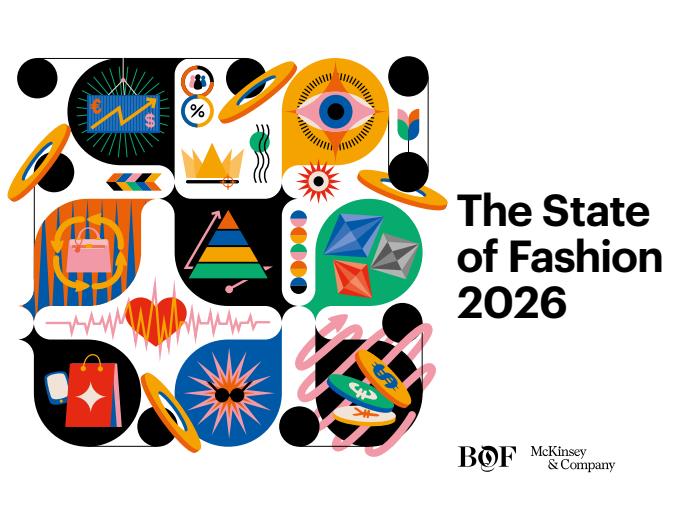As fashion executives look to 2026, they are contending with a fundamentally new reality. US tariffs have redrawn trade maps and forced brands and their suppliers to rapidly adjust. Consumers continue to rethink their spending, seeking value and devoting more of their budgets to achieve other goals, including their own well-being and longevity. The swift onset of AI, meanwhile, means fashion businesses find themselves in a rapidly changing technological landscape.
While the ongoing disruptions may feel daunting, they are in fact part of a wider set of longer-term systemic shifts. The Business of Fashion and McKinsey have been tracking global economic dislocations, shifting consumer preferences, and changes to the fashion system in The State of Fashion reports for ten years now. The publication of our first report in 2016 coincided with the Brexit vote in the United Kingdom and the first election of Donald Trump as president of the United States. Since then, we have examined the impact of a once-in-a-generation pandemic, global supply chain upheaval, and the industry’s track record on sustainability, among many other macro themes.
Whereas in previous years fashion leaders, facing the volatility of global affairs, weren’t certain about what lay ahead, now they seem to have accepted that constant change is simply the new normal. “Challenging” has overtaken “uncertainty” as the word executives polled in the annual Business of Fashion–McKinsey State of Fashion Executive Survey used most frequently to describe the industry in 2026, with tariffs cited as the number-one hurdle.
Perhaps unsurprisingly, then, many leaders are feeling pessimistic. This year, 46 percent said they expect conditions to worsen in 2026, compared with 39 percent in last year’s survey. By geography, 36 percent viewed North America as unpromising or very unpromising, double last year’s share.
But not everyone is so downbeat. Among those polled, 25 percent believe industry conditions will improve, up from 20 percent in 2025, suggesting some players see pockets of opportunity. Sentiment toward China is finally picking up, even as conditions remain difficult: 28 percent viewed the market there as unpromising in 2026, down from 41 percent heading into 2025.
The industry’s main agenda in 2026 will be adapting to a new environment where trade, consumer behavior, and technology remain in rapid flux. Agile brands that can adapt quickly are likely to emerge as the winners.
Low growth lingers
A McKinsey analysis projects that the global fashion industry will once again post low single-digit growth in 2026. Heightened macroeconomic volatility is expected to continue to weigh on sentiment and drive value-conscious consumer behavior. This is particularly evident in the United States, where consumer sentiment was especially low in 2025. (In April, amid tariff announcements, consumer confidence hit its lowest level since May 2020.) Overall, we expect US industry growth to fall short of last year’s forecast for 2025 (Exhibit 1).

In Europe, GDP growth is expected to remain steady, underpinned by a resilient labor market and stable unemployment rates. Even so, consumers are expected to remain cautious, trading down across purchase categories. As for China, GDP growth is expected to slow, and disposable income growth is also expected to fall below 2024 and 2025 levels. (To be sure, there are bright spots in the Chinese fashion market, particularly in sportswear.)
The luxury segment, meanwhile, is projected to see modest improvements across markets after a difficult 2025, supported by a flurry of creative resets fashion leaders hope will inject excitement into the industry. Brands are again investing in the US luxury market: Retail square footage rose 65 percent in the first half of 2025, compared with a decline in the year prior, reflecting efforts to restore growth.
State of Fashion 2026 webinar
Join us for an exclusive webinar that explores the findings of the State of Fashion 2026 report.
AI brings opportunities
With turbulent conditions, including volatile input costs, supply chain disruptions, and slow growth, straining fashion’s economic model, AI is shifting from a competitive edge to a business necessity. Companies are reshaping workforces accordingly, with some existing jobs becoming more AI-centric, enabling roles to shift toward higher-value creative and analytical tasks.
Global fashion and luxury players have made progress deploying automation with generative AI in select functions for routine tasks. More than 35 percent of executives report already using it in areas such as online customer service, image creation, copywriting, consumer search, or product discovery. While finance and manufacturing roles will see the greatest overall impact from automation without gen AI, automation with gen AI could lead to huge productivity gains for fashion players in their marketing and sales functions (Exhibit 2).

To harness this technological change, companies must redesign their processes and compete for AI talent, looking beyond the fashion ecosystem to find it while protecting the essential creativity that makes fashion tick. Business leaders will need to shift their focus from small pilots and experiments that can only deliver incremental change toward a more fundamental reassessment of how their organizations work. And while still nascent, agentic AI is reshaping how people work and collaborate, so fashion companies will need to figure out how they can harness this emerging technology, too.
AI is also transforming how people shop. Customers are turning to large language models to search for products, compare offerings, and receive tailored recommendations. Some are even using agents as style and wardrobe consultants (these agents give advice on what to buy and where to buy it). These shifts make AI chatbot responses the new SEO.
These dynamics will only grow more pronounced as agentic commerce accelerates in the second half of the decade.
THE STATE OF FASHION 2026: 10 THEMES










New consumer priorities and competitors emerge
Fostering customer loyalty is emerging as an important front line in the battle for customers, with more than half of executives citing retention strategies as a key theme shaping the industry in 2026.
To attract—and retain—customers, brands will need to give them what they want, and increasingly, that means offering value. While luxury players raised prices without corresponding improvements in product quality or creativity, design-led brands from the value segment up through affordable luxury elevated their products and store experiences. Now, the midmarket is the fastest-growing one, and it’s replacing luxury as fashion’s main value creator.
As consumers confronted price increases across apparel brands in the last year, one category in particular—jewelry—increased prices on average more slowly than others did. This dynamic, combined with consumers’ desire for lasting investments and a rise in self-gifting among both men and women, means the jewelry market is thriving. The category is forecast to be the fastest growing in fashion by unit sales, growing at more than four times the rate of clothing.
Elsewhere in accessories, smart eyewear that blends fashion and technology is poised for a breakout year. Several product launches are expected in 2026, with the offerings striking a balance between function and fashion in ways that may land better with consumers than earlier offerings did.
Luxury, for its part, is now embarking on a period of reinvention. In an effort to reignite demand, several of the largest luxury houses welcomed new creative directors in the year through September 2025. Among high-net-worth individuals, higher product quality and craftsmanship and better in-store service are among the top factors that would encourage them to buy more from luxury brands in the year ahead, although there were notable regional differences among shoppers in China, the United Kingdom, and the United States (Exhibit 3).

While luxury executives revamp their product offerings, they are also resetting after a period of mostly price-led growth. Luxury executives expect to increase prices in the year ahead less than those in other segments (26 percent of executives in fashion expect to increase prices by more than 5 percent compared with 18 percent in the luxury segment). Still, high prices remain a significant hurdle for aspirational customers. Luckily, the resale market—forecast to grow up to three times faster than the firsthand market through 2027—affords luxury players a way to build loyalty with existing shoppers and drive purchases with aspirational shoppers looking for more accessible price points.
Indeed, the resale market offers an opportunity to brands across price segments, not just to luxury players. The secondhand fashion and luxury market is forecast to grow two to three times faster than the firsthand market through 2027, as consumer appetite grows and scales, and technology unlocks profitability for resale platforms. And concerns that resale could cannibalize firsthand purchases, a common fear among industry leaders, aren’t supported by the data: Consumers across the United Kingdom, the United States, and China use resale to explore aspirational brands for future purchases (Exhibit 4).

Beyond influencing choices between first- and secondhand fashion, the search for value and enrichment is prompting consumers across income levels to redirect discretionary spending toward nonfashion categories that deliver on these aims. As a result, many are focusing their spend on their personal wellness: body, mind and health, a trend we first called out in 2017. The shift presents a unique way for fashion players to branch out into new adjacencies, assuming it makes sense for their brand.
In the end, 2026 will likely be another year of dislocation for fashion companies. On one hand, the market is expected to see low growth, trade reconfigurations, and tech disruption. On the other, there are category-specific green shoots; rapidly evolving tools that will redefine how goods are created, discovered, and sold; and an injection of new creative energy that could revitalize the market. The rules governing the fashion system may now be in flux—which means there are opportunities for companies to rewrite them altogether.
Download the full report on which this article is based, The State of Fashion 2026: When the rules change (PDF–8MB).



